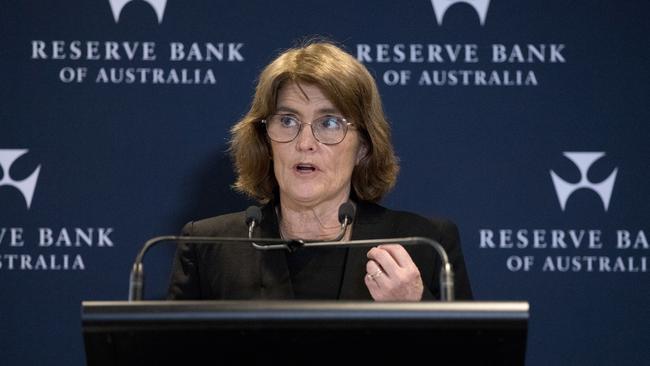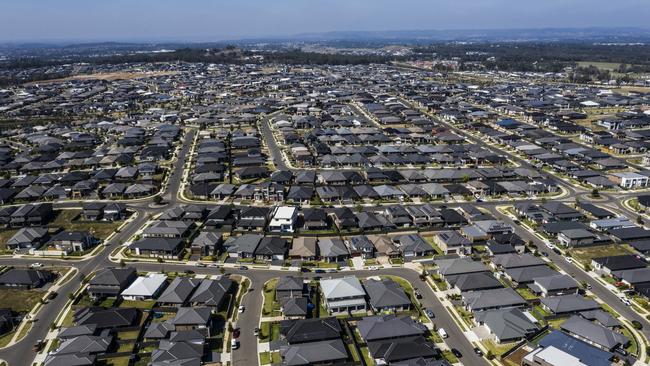Reserve Bank makes cautious interest rate cut as inflation pressures weigh, say economists
Economists warn that the central bank’s cautious approach suggests limited rate relief ahead as inflation concerns and a tight labour market weigh heavily.
Business
Don't miss out on the headlines from Business. Followed categories will be added to My News.
Economists have warned that while the Reserve Bank of Australia offered some relief to mortgage holders on Tuesday with its first interest rate cut since 2020, a renewed commitment to its inflation-fighting mandate could leave households waiting for a second cut.
Having kept rates at a 13-year high since November 2023, the RBA’s decision to reduce rates by 25 basis points to 4.1 per cent was anticipated by most economists after softer-than-expected inflation data showed underlying price pressures nudging the top of the RBA’s 2-3 per cent target band.
But rate relief offered no tailwind at all to investors on the sharemarket following what economists saw as a hawkish cut by a reluctant central bank vigilant to inflation risks, particularly from the tight labour market and external factors such global trade barriers.
AMP chief economist Shane Oliver said the RBA was cautious on future cuts, having delivered a “hawkish” rate cut and pushing back against market forecasts of multiple rate cuts this year. The bank also revised its trimmed mean inflation forecast slightly upward for 2026.
“It is concerned that if it eases too quickly, inflation could settle above the midpoint of the target,” Dr Oliver said.

“This cautious cut effectively pushes back against market forecasts for further rate cuts, signalling that the RBA believes inflation is likely to stay higher than anticipated. So it doesn’t look like the RBA will be rushing into another rate cut just yet.”
The bank’s post-meeting statement warned Australians if monetary policy is eased too much too soon, disinflation could stall, and inflation would settle above the midpoint of the target range. RBA governor Michele Bullock warned at her press conference that Tuesday’s cut was not the start of more rate relief until inflation risks subsided further.
EY chief economist Cherelle Murphy cautioned that while the RBA is shifting towards a neutral policy stance, it will need to remain vigilant to inflationary risks, particularly those stemming from the tight labour market, high government spending and global supply-side pressures, including tariff and protectionist policies.
“The cut represents the first move towards neutral policy, but came with a hawkish tone,” she said. Ms Murphy’s outlook suggests the RBA will likely hold the cash rate steady for now to assess the impact of the rate cut, and monitor inflation trends.
Labor and its allies have put pressure on the bank to provide voters rates relief before they go to the polls and decide whether to re-elect Anthony Albanese. Government ministers on Monday said Australians “deserve” a rate cut and that people were “hoping” for relief.
Oxford Economics Australia’s Sean Langcake said while the decision was in line with market expectations, the RBA faced a complicated balancing act of a tight labour market and ongoing inflation pressures.
“The RBA has been tasked with putting more weight on labour market conditions in their policy decisions. With the labour market still in an inflationary position and showing few signs of easing, we are a little surprised by today’s decision,” Mr Langcake said.
He pointed to the ongoing pressure in the services sector and improving consumer spending, which suggest the economy has more resilience than the rate cut might imply.
Mr Langcake said that in the short term, the RBA will need to keep a close watch on the labour market, with recent data suggesting that the jobless rate remains tight.
“A fall in the unemployment rate in Thursday’s data would be hard to reconcile with this rate cut,” he said.
Despite these risks, the RBA’s latest forecasts signal optimism that inflation will moderate further. The central bank revised its expectations for underlying inflation to fall to 2.7 per cent by mid-2025, with this forecast brought forward from the previous expectation that inflation would remain above 3 per cent until the end of 2025.
KPMG senior economist Michael Malakellis said the RBA faces significant challenges ahead, particularly as government fiscal policies could exert upward pressure on inflation.
“If underlying inflation is persistent and outside of its target range, then starting the easing cycle exposes the economy to upside inflation risks that are still lurking,” Dr Malakellis said.
He said a bounce-back in the second half of 2025 most likely would reflect the removal of cost-of-living measures, particularly the Energy Bill Relief.

“Any future Energy Bill Relief measures (or other cost-of-living measures) will have the effect of reducing the headline measure of inflation (relative to the RBA’s forecast),” he said.
“Future Energy Bill Relief measures could impact trimmed mean inflation if households are encouraged to spend more on other goods and services. Our view is that this impact is likely to be small.”
Mr Langcake said utility rebates offered by state and federal governments had hastened the fall in inflation over the past six months, and are a large part of the looming spike in inflation the RBA is forecasting in the second half of the year.
“A fresh round of utilities bill relief would keep downward pressure on inflation in the affected period. But whenever the support lapses, inflation will spike,” he said.
Deloitte Access Economics partner Stephen Smith said the rates decision was overdue, given sluggish economic growth and softening wage pressures, but added that it was somewhat of a surprise that the RBA’s messaging in recent months had emphasised the need to keep rates elevated in the face of ongoing inflationary pressures.
“Today’s decision appears to be a concession by the bank that the level of demand in the economy is not too high relative to supply after all,” he said. “Indeed, as well as being a win for households, today’s decision was also a loss for the credibility of the Reserve Bank’s communication. Today’s cut is at odds with the consistent messaging of the bank over the past year.”
Labor has been pushing back against the independent RBA since August, when Jim Chalmers disputed the central bank’s finding that the economy was running too hot. The Treasurer in August claimed Labor’s energy rebates were putting downward pressure on inflation despite the RBA clarifying the budget’s key cost-of-living measure would not lead to a faster reduction in the 4.35 per cent cash rate.
More Coverage
Originally published as Reserve Bank makes cautious interest rate cut as inflation pressures weigh, say economists





